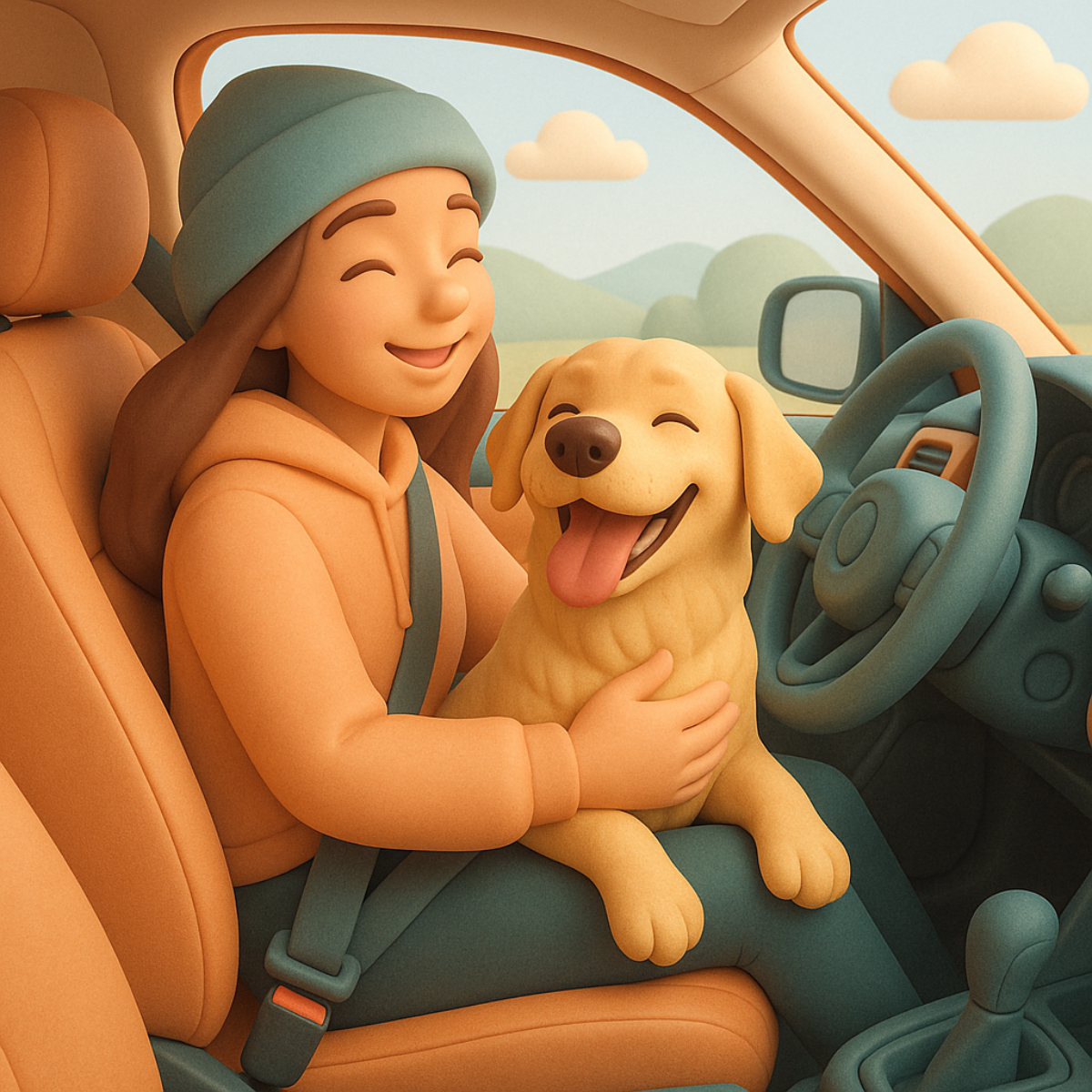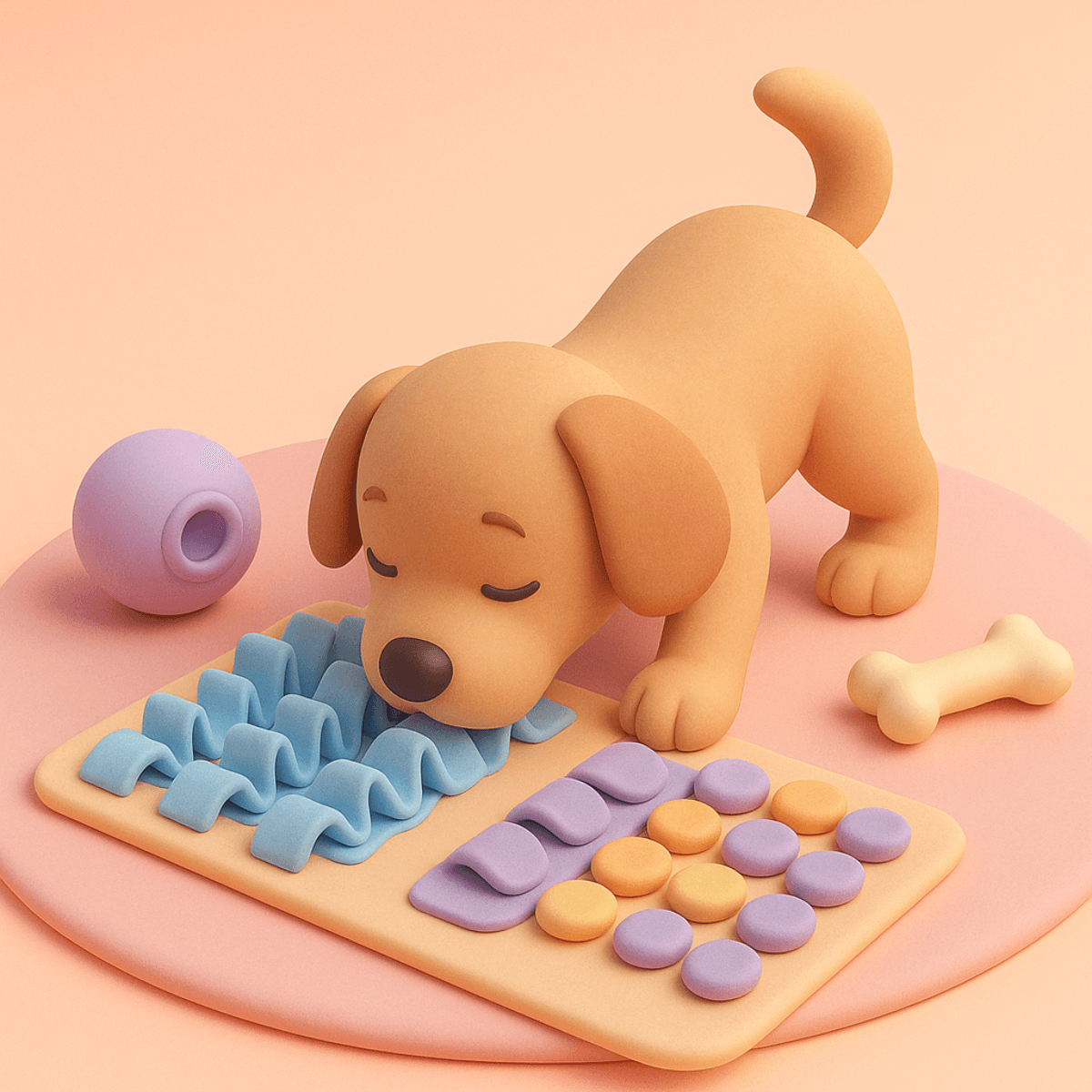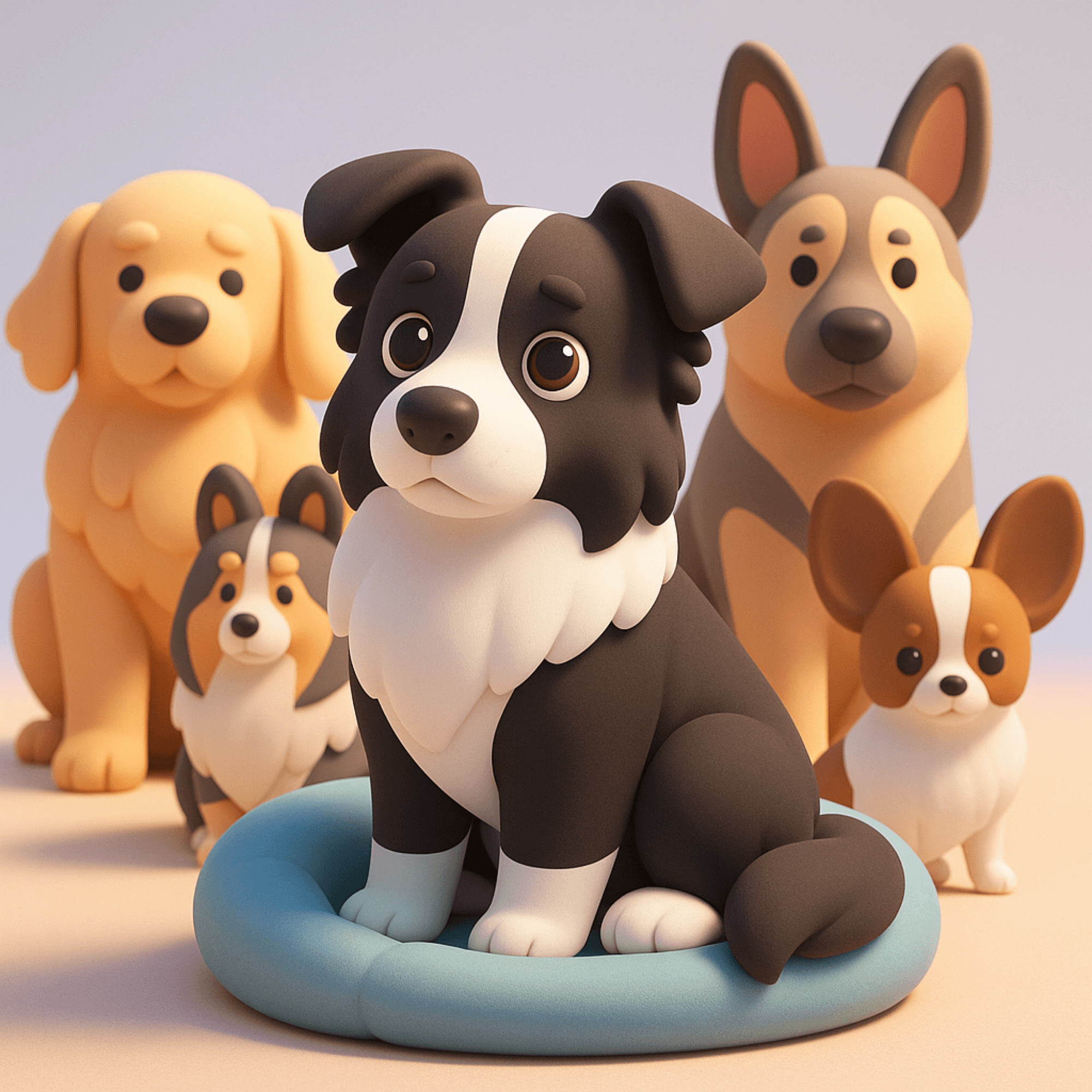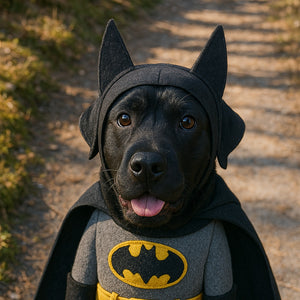
This mistake could cost your dog's life – how to safely transport a dog in a car?
Imagine you're driving peacefully in the car with your beloved pet. Your dog looks happily out the window, wagging its tail, and you're enjoying its presence. Suddenly, someone brakes suddenly in front of you— screeching tires, jerking the steering wheel . In a split second, your entire world turns upside down. Is your pet safe? Is safe dog transportation something you've thought about in advance, or will a dramatic event be the real deal? This story isn't fiction—such situations actually happen. Many owners don't realize that improperly transporting a dog in a car can lead to tragedy in a split second.
Unconscious risk – dangers of transporting a dog incorrectly

We love our dogs like family, but do we ensure their safety on the road as we do our loved ones? Unfortunately, the answer is too often no. A loose dog can become a living projectile during a sudden stop or collision. According to data from the organization Bark Buckle Up, a dog weighing 27 kg (50 lbs) in a collision at just 56 km/h (35 mph) impacts with a force of over 1,200 kg (2,000 lbs) ! It's hard to imagine – it's as if the weight of an almost small car had hit something. It's no wonder the consequences are so disastrous. Veterinarians describe typical injuries for dogs in such situations as bruises and abrasions , broken legs, spinal injuries, internal bleeding , and even death at the scene. Worse still, passengers can also suffer – an unrestrained dog can strike people with tremendous force.
But it doesn't even take an accident for a dangerous situation to occur. A distracted driver is a deadly threat on the road. In 2020, 3,142 people died in distracted driving accidents in the United States alone. And did you know that an unrestrained dog in the car is as distracting a driver as texting while driving ? Think about it – a dog jumping on the seats or trying to climb into your lap while driving is a recipe for tragedy. A small dog can get under the brake pedal, preventing you from stopping. A larger dog can suddenly block your view by leaning between the seats. In a moment of danger, you won't be able to react in time.
Dramatic scenarios also unfold after an accident . If a dog is not restrained and is thrown from the car, it can suffer fatal injuries or... flee in panic, right under the wheels of the cars ahead. Emergency services often lack the means to immediately attend to a terrified animal that may be running injured on the road. It's not hard to imagine how devastating it would be to lose a pet in this way or watch them suffer because of our carelessness.
What do dog owners themselves say? Most are aware of the danger , but few actually do anything about it. An American Automobile Association (AAA) survey found that 84% of drivers know that driving with an unrestrained pet is risky, yet only 16% use any kind of restraint for their dog . It's alarming – many of us blindly trust to luck, thinking "it won't happen to me." The truth is, however, that accidents happen , even on short, familiar routes. Our friend can become the victim of our negligence in a split second.
A dog is a member of the family. Would you let a loved one ride in a car without a seatbelt? Probably not. So why should your beloved pet be treated any differently?
What does the law say? European regulations regarding transporting a dog in a car.
Emotional and common sense arguments are one thing, but there are also legal regulations that oblige us to ensure the safety of animals while driving. In many European countries, a dog in a car is treated like any other "cargo" – it must be properly restrained to prevent it from moving freely during transport. This is not only for the well-being of the animal itself, but also for the safety of the driver, passengers, and other road users.

For example, the British Highway Code explicitly states that a pet should be properly secured in a vehicle to prevent distracting the driver and causing a hazard in the event of a sudden stop . Similar rules—though sometimes less explicitly—apply in most EU countries. Police and road authorities are increasingly paying attention to this aspect during inspections. In some countries , carrying a dog unattended can result in hefty fines , reaching up to several hundred euros . While the specifics of the law may vary from country to country, the general idea is the same: a dog should be secured so that it doesn't interfere with the driver's movements and isn't injured in the event of an accident .
It's also worth remembering that in the event of a collision, the insurer may refuse to pay full compensation if it turns out the accident was caused by your inattention caused by a dog running around the car. Failure to properly transport your pet can be considered gross negligence. In short, both the law and common sense require us to take care of our pets while traveling .
Types of security – how to transport a dog safely in a car?
Now that we know that safely transporting a dog in the car is essential, let's take a look at the available solutions . The market offers a growing number of accessories that protect pets while traveling. The choice depends on factors such as the dog's size, the type of car, and whether our pet can travel safely. Here are the most popular types of dog car seat protection :
Dog harnesses and seat belts
Special dog seat belts are one of the simplest and most commonly used solutions. They typically consist of a harness worn around the dog and a short leash/clasp that clips into the vehicle's seat belt buckle or attaches to an ISOFIX mount. Never strap your dog to a collar —if pulled, it could cause neck injury or strangulation. Instead, we use a harness that wraps around the chest.
A well-fitting car harness distributes the force of impact to the strongest parts of the dog's body and keeps them in place during a collision. It's important to choose a high-quality product – preferably crash-tested . Unfortunately, there are no official safety standards for such accessories (unlike child seats), so there are also poor-quality products on the market. It's worth looking for harnesses with certificates or test results (for example, the Center for Pet Safety conducts independent crash tests and publishes the results). The American Veterinary Medical Association (AVMA) recommends using special harnesses that attach to the seat belt – different from standard stroller harnesses – that will keep the dog seated while driving. A dog restrained by a seat belt should travel in the back seat . This is important because even if you have a small dog that fits in the front seat, an airbag deployment in a crash could seriously injure them. The back seat is much safer for pets.
The advantage of harnesses and seat belts is their versatility – they're easy to adjust to fit different cars, and your dog has relative freedom of movement, allowing him to sit or lie down on the seat. The downside is that a very energetic or restless dog can get tangled in the harness, and not every dog tolerates restricted movement. Therefore, before a long journey, it's a good idea to accustom your dog to the harness at home and on short trips (we'll explain how to do this later).
Carrier or cage (kennel)
A carrier (kennel) is a closed cage or sturdy bag/container for transporting animals. This solution is often chosen for smaller dogs , but there are also large cages for larger breeds, mounted, for example, in the trunk of a station wagon or SUV. The idea behind a carrier is to limit the space in which the dog stays so that, in the event of an accident, it doesn't get thrown and hits the cage walls, rather than directly into the car or passengers. A well-designed carrier absorbs some of the impact energy, protecting the animal.
However, it's crucial to properly secure the carrier itself in the car . A loosely placed carrier on the seat or in the trunk will start flying around the car in a collision, along with the dog inside, defeating the entire purpose of securing it. Therefore, the carrier should be placed securely – ideally on the floor behind the front seat or secured with a seat belt. The AVMA recommends positioning the carrier as centrally as possible in the vehicle and securing it to prevent movement . For larger carriers in the trunk, they should be secured with seat belts or special attachments to the carrier floor brackets.
The right size of the carrier is crucial. The dog must be able to stand, turn around, and lie down comfortably in it , but a cage that's too large can cause the dog to move more freely in the event of an accident. It's worth investing in a carrier made of sturdy materials (e.g., reinforced plastic or metal) – a cheap, plastic kennel can crack on impact. Special crash-tested cages are available (often used by people who travel frequently with their dogs). While they cost more, they provide greater safety.
Another advantage of a carrier is that it provides many dogs with a sense of refuge – they feel more at ease in their familiar "nest," especially if they're lined with their favorite blanket. The downside is carrying and carrying a heavy crate, and there may not be enough space for it in a small car. For larger dogs traveling in the trunk, a mesh screen separating the cargo area from the passenger compartment is also useful, to prevent the dog from jumping in – however, the screen alone won't provide the same level of security as a screen secured inside the trunk.
Dog car seat – comfort and safety in one
Special car seats for dogs are becoming increasingly popular. They resemble a soft, built-in bed mounted on the car seat , usually with built-in seat belts and a leash for securing the dog. These seats combine the advantages of a harness and a carrier – they restrict the dog's movement and protect it in the event of an accident, while also being soft, comfortable, and allowing the animal to observe its surroundings. For small and medium-sized dogs, this is often an ideal solution, as they can sit elevated, see out the window, and are simultaneously surrounded by the seat's soft walls , providing a sense of security.
Many models are available on the market, but it's worth choosing proven, solidly constructed ones . The seat should be secured to the vehicle seat with a seat belt or have its own Isofix anchor straps – this prevents the dog from falling forward in the event of a crash. The dog inside should be attached to the harness with a short leash (not just to the collar!). It's best if the seat has high sides and comfortable padding – it acts as a protective cradle.
An example of a top-class product in this category is the PETTO Oi collection – dog car seats that combine safety, comfort, quality craftsmanship, and style . The PETTO Oi is designed with maximum pet protection and travel comfort in mind. It features a contoured structure, sturdy seat belts , and a harness option, ensuring your pet remains stable even under heavy braking. The interior is made of luxurious, hypoallergenic materials , making the seat cozy and safe for your dog's skin. Even long journeys won't be tiring for your dog – the soft cushion and breathable fabrics ensure the highest level of comfort. Stylish design is also important – seats from the Oi collection look elegant and easily fit into your car's interior, combining functionality with aesthetics. This type of seat is a 2-in-1 solution: it ensures safety while also being a visually appealing addition to your car's equipment. The dog treats it as its bed – after the trip, such a seat can even be taken home and used as a bed, which increases the pet's comfort in new places.
In summary : choosing a restraint system should be tailored to your dog and your travel style . Whether it's a seat belt, crate, or car seat, the worst thing you can do is not use any restraint at all. A dog should absolutely not travel "loosely" in a car. Remember, even the best accessories are useless if you don't teach your dog how to use them and properly secure them. That's why it's so important to properly prepare your pet for the journey.
First trips and learning – how to prepare your dog for a car ride?
Your dog may not initially understand why you're suddenly ordering him to sit in a carrier or strapping him in. Training and gradually acclimating your pet to car travel is key. Here are some practical tips for accustoming your dog to driving and this new way of traveling:
- Slow acclimation – start small . The American Society for the Prevention of Cruelty to Animals (ASPCA) recommends preparing your pet for longer trips with a series of short trips, gradually increasing the time spent in the car . To start, you can simply sit your dog in a parked car, give him a treat, run the engine for a moment, and… that's it. The next day, take a short drive around the block. Then a few miles to the park or store. Praise and reward your dog for calm behavior. Gradually build a positive association: car = fun .
- Car etiquette training – if you plan to transport your dog in a car seat or in the back seat with a seatbelt, teach them to calmly get in and out on command. Practice the “in” command in the car – so your dog jumps into their carrier/car seat when you show them and stays there until you let them out. Initial attempts can be difficult , as excitement or stress can set in. Be consistent, however – if your dog tries to jump out of the seat, stop the car and calmly call them back. Don't yell – the driver's patience and calm will rub off on your pet.
- Familiar Smells and Items – Help your dog enjoy his new car space by providing it with a favorite blanket, toy, or pillow . His own scent has a soothing effect. The ASPCA suggests taking his dog's favorite stuffed animal with him to give him a taste of home while traveling. When a dog feels safe and comfortable, he's less likely to panic or feel nauseous.
- Avoid negative associations – if your only rides so far have been trips to the vet for shots, it's no wonder your dog frowns on cars. Try to do your first training sessions in fun circumstances – a walk to a new place, a dog park, or a lake. Let them be rewarded with a fun activity at the end of the ride.
- Adjust the travel environment – dogs have much more sensitive hearing and can sometimes react anxiously to engine noise or the sounds of traffic. Try playing soft, relaxing music or simply talking to your dog in a calm voice while driving. If you hear sirens or horns, you can slightly increase the volume to mask these sounds. Your dog will become more accustomed over time, but be understanding of their potential nervousness at first.
Motion sickness in dogs – how to help your pet?
Some dogs, especially young ones, suffer from motion sickness just like humans. Symptoms include drooling, yawning, restless pacing, and eventually vomiting while traveling. The cause may be an immature labyrinth in puppies —many puppies outgrow this hypersensitivity around the age of one. For others, the problem is neurological—anxiety and stress exacerbate nausea. Here are ways to alleviate the symptoms and provide relief for your dog with motion sickness :
- An empty (but not too empty) bowl before the journey – don't feed your dog generously just before the journey . Try to have their last meal no later than 3-4 hours before departure , and preferably light. Stop giving treats about an hour before the journey. But don't travel with a dog that's been completely hungry for hours – an empty stomach can worsen nausea. A small portion of dry food beforehand, plus access to water (until departure), is a reasonable compromise.
- Air out your car – fresh, cool air can work wonders. If your pet is prone to nausea, ensure good air circulation in the car. On warm days, crack the windows (but remember to protect your dog from trying to look out too much – it's dangerous to put your head outside!). Air conditioning will also help maintain a comfortable temperature. Veterinary experts note that cooler air alleviates symptoms of nausea in dogs . Avoid using strong air fresheners or perfumes in your car – strong scents can exacerbate nausea.
- Limit movement and visual stimuli – dogs that stare out the side windows at the rapidly flashing world may experience increased discomfort. Movement outside the window sends conflicting signals to the labyrinth, which increases nausea. Therefore, if your dog is experiencing motion sickness, try seating it so it's facing forward (e.g., with the carrier facing away from the side door, or the car seat in the middle of the back seat). WebMD veterinarians emphasize that dogs experience less nausea when facing the direction of travel and not looking out the side windows . Some owners block part of the crate's view, for example, with a light blanket, to limit visual stimuli – this is worth testing if your dog constantly looks out and then becomes ill.
- Natural remedies and vet support – if it works for humans, will it work for dogs too? Ginger is a well-known natural antiemetic. You can ask your vet about giving your dog ginger before traveling – in the form of ginger tea (cooled) or ginger cookies. There are even ready-made ginger preparations for animals. However, remember to always consult your doctor before giving anything new. For severe cases of motion sickness, your vet may prescribe prescription medications , such as Cerenia (maropitant), an effective antiemetic for dogs. Antihistamine tablets with sedative and antiemetic properties are also available from veterinarians. Never give your dog "human" medications for motion sickness without your doctor's approval! Some can be toxic to your dog.
- Rest breaks – if you have a longer route ahead, take regular breaks . A short walk every 2-3 hours will allow your dog to get some fresh air, relieve himself, and de-stress from the activity. Even 5-10 minutes outside can be a huge help in relieving nausea. This will also help you check if everything is okay – whether he's overly stressed, dehydrated, etc.
Remember that many young dogs become accustomed to riding over time and their balance systems mature, so motion sickness may disappear. However, if your dog still has trouble traveling despite training and the above tips, consult your vet. Together, you can find the best solution to make traveling less of a chore.
A dog as a family member – emotions, bonds and our responsibility
When we look into the trusting eyes of our dog, we see unconditional love and loyalty. The bond between human and dog is unique – we treat them as full members of the family. In return for their devotion, we must ensure their well-being, as they cannot take precautions on their own. Our pet's safety rests in our hands .
Think of the thrills that accompany shared road trips – the excitement of a dog heading out on a trip to the countryside; the joy of sticking its head out into the breeze (though remember, sticking its head out the window is dangerous – it's better to crack the window so it can smell the scents but not lean out). For many of us, a dog is like a child . Would we hit the road with a child not strapped in or without a car seat? Never. So why do we still find ourselves driving with a dog on our laps or letting them run around in the backseat?
We might think that "my dog always sits politely, nothing will happen." But in a critical situation, this doesn't matter – even the most well-behaved dog won't resist the inertia of its body during a collision. It's up to us, as caregivers, to anticipate threats. Loving a dog isn't just about cuddling and spoiling them with treats. True love manifests itself in caring for its life and health – even (and perhaps especially) when it doesn't understand the danger itself.
Many drivers say after an accident involving an animal, "If I could turn back time, I would never have let it happen." Someone lost a beloved dog because it was thrown through a window. Another narrowly escaped with their life because the force of the impact caused a large dog to fall onto their back, causing spinal injuries. Such tragedies leave lifelong trauma and guilt . Yet they could be prevented with such little effort —all it takes is a few minutes to buckle the dog in or place it in a carrier before driving off. It's a moment that can make all the difference.
Safe transport of your dog – your duty and an act of love

Our dog would give his life for us – let's do everything we can to protect him too . Safely transporting your dog in the car isn't a luxury or a whim; it's a fundamental responsibility of a responsible owner . Now that you know the risks and solutions, it's time to move from words to action. Look for the best way to protect your pet. Perhaps it's a sturdy, certified harness, or perhaps a comfortable dog car seat like the PETTO Oi, which will provide protection and comfort. Regardless of your choice, don't delay . Every unsecured trip is a gamble with fate, and it's not worth accepting.
Take care of your dog just as you would other beloved family members. Buckle him up before you turn the key in the ignition. Teach him that the car can be a fun place, and that a seat belt or carrier simply signals that you're on your way to another adventure. This way, you'll drive with more peace of mind, and your pet will be safe and relaxed.
Don't wait for a disaster to strike. Be proactive: equip your car with the right dog transport accessories today and put our tips into practice . Show your four-legged friend that your love also means caring for their safety. Every trip together can be a wonderful adventure – provided everyone arrives safe and sound. Your dog trusts you completely – don't let him down. Secure him in the car and set off together towards more memories, fearless and risk-free.
> Safety is a choice. Choose wisely – for yourself and your best friend.
🔎 Dangers and dog safety in the car
-
Harness and Carrier Crash Tests – Center for Pet Safety
Independent crash tests of dog accessories reveal the real level of safety offered by belts and cages. -
Animals in the car = driver distraction – AAA Exchange
Data showing how the presence of an unrestrained dog affects driver attention and increases the risk of a crash. -
Animal Safety Campaign – Bark Buckle UP
An initiative promoting the safe transport of pets – education and certificates. -
Distraction by the Numbers – NHTSA
The official U.S. National Highway Traffic Safety Administration campaign on risk factors, including animals in cars.
⚖️ International law and recommendations
-
Rules for the carriage of animals - British Highway Code
The obligation to secure a dog in the car in the light of European road traffic regulations. -
Safe Travel for Your Pet – AVMA
American Veterinary Medical Association recommendations for animal transport.
🧳 Motion sickness and preparing your dog for travel
-
How to Prepare Your Dog for a Ride – ASPCA Advice
Practical tips on how to accustom your pet to the car and reduce travel stress. -
Motion Sickness in Dogs – WebMD
Symptoms, causes and ways to prevent nausea while driving. -
Cerenia (maropitant) – an effective antiemetic drug
Information about a drug used by veterinarians to treat motion sickness in dogs and cats.
- 🏙️ Best dogs for apartments – breed ranking
- 💬 How Do Dogs Show Affection? Signals You Should Know
- 🐕 Is your dog pulling on the leash? Find out how to fix it.
- 🚗 How to safely transport a dog in a car?
- 🐾 How to teach your dog to stay home alone
- 🛏️ Can a dog sleep in bed with its owner? Facts, myths, and behavioral advice.
See more at: Petto.com.pl
















































 https://petto.com.pl
https://petto.com.pl